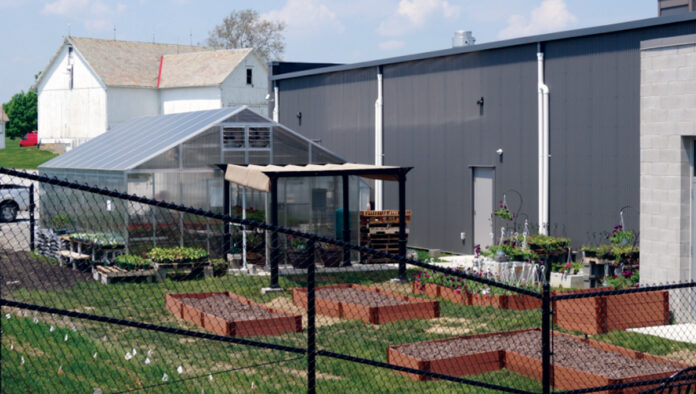
SALEM, Ohio — When the Carrollton Exempted Village School District hired Barbara Burns to turn around the school’s nutrition program 11 years ago, they also had high hopes for a farm-to-school program that would save the district money by growing their fruits and vegetables. The district used $50,000 from an Ohio Department of Education Straight A grant for a greenhouse and handed Burns the reins.
The greenhouse was built, but fruit and vegetable production did not meet expectations.
“They wrote the grant because they wanted to have a greenhouse,” Burns said. “They thought that by putting in this greenhouse they were going to save the cafeterias $30,000 by growing their fruits and vegetables. That’s not possible. That’s production farming.”
However, that wasn’t the end of the program. With the support of administration and grant money, Burns has been able to scale the farm-to-school program and supplement fruits and vegetables in the cafeteria, expose students to various agricultural practices and incorporate nutrition and agricultural practices into the curriculum.
“What I’ve learned with farm to school is it’s one thing to do production but most schools are just going to be able to do small-scale projects where they involve kids with hands-on experiences,” Burns said.
“It may be something as simple as putting lettuce on a salad or making a little side salad and then taking cherry tomatoes that we harvested and putting one or two tomatoes on each salad. I just want to be able to save the cafeteria some money and I want the kids to have hands-on learning experiences.”
Recipe for success
Farm-to-school programs in Ohio have been around for decades. However, the number of schools participating in farm-to-school programming is inconclusive. The U.S. Department of Agriculture’s Farm-to-School Census occurs every four years, the last one was in 2019 and indicated that 58.3% of Ohio respondents participated in some form of farm-to-school activities.
Schools voluntarily reply to the USDA’s survey, and that’s what makes it difficult to get an actual count of participating schools.
“We don’t know exactly how many schools are involved and to be quite honest,” said Elizabeth Douglass, Ohio Department of Education and Workforce Development’s assistant director in the Office of Nutrition. “We only really hear about it when someone is either interested in getting started or if they have a quite successful operation and we’re invited out to see it.”
Longevity and sustainability are the goals of farm-to-school activities and while they vary in size and scope, well-developed and sustainable programs are built on common factors. Douglass said three elements make a successful program: an energetic person to lead the effort, administrative support and embedding it in the school operations. Carrollton’s initiative is an example of elements coming together.
“They have Barb Burns, who’s amazing,” Douglass said. “And they have a very committed superintendent and school board supporting the work that they do.” And they have Burns’ ability to innovate and institutionalize programming.
Examples of Carrollton’s Farm to School initiative include a Mother’s Day plant sale that generated $8,000; acquiring a $146,000 Action for Healthy Kids Grant to purchase Flex hydroponic grow panels to grow lettuce for school meals; creating additional opportunities for firsthand experiences for students K-12 and involving students in designing cafeteria menu items through test kitchens and hiring Kay Russell, a veteran Carrollton teacher as the district’s full-time outdoor educator.
Bridging the gap
Russell’s presence in particular adds a curricular element to the program, Burns said. Burns, the school’s nutrition director, is trained as a registered dietitian. She leans on Russell to bridge the gap between food and education. The pair wanted to do more than have classes visit the greenhouse or growing area without a learning component attached.
“It’s like if you’re gonna plant a seed, you don’t put a seed in the ground and check on it three months later in the fall. It has to be nurtured, you have to weed the problems out along the way,” Burns said. “By having Kay as that outdoor educator, she’s the one nurturing and watching it grow. If you don’t have that person the spot treatments aren’t going to help.”
Through Russell’s creative efforts and ability to look beyond traditional programming, farm-to-school activities are happening districtwide. There’s no formal outdoor education curriculum, but Russell uses the state education standards and her vast network of connections to craft educational opportunities. Students don’t always have to be in the greenhouse to benefit from a learning opportunity.
“What I’m doing is videoing,” Russell said. “First grade did something with pumpkin seeds in the greenhouse and once a week I make a video and send it back to first grade to show them the height, and what’s going on with growth — the science end of it.”
Second and fourth graders participated in a winter harvest by taking squash and conducting taste panels with three different squashes. Third graders started a fall vegetable soup garden, something Burns wanted to do.
“We had the fourth graders plant potatoes in the spring, when they came back this fall, Kay took them back out, harvested them, and then turned the potatoes over to the school cafeteria. We had a baked potato day for the now fifth graders,” Burns said.
Because Russell is not new to the district, she’s been able to leverage relationships and get staff buy-in on her lessons and activities.
“You need that liaison,” Burns said. “You need somebody working between the greenhouse, the gardens and the classroom.”









